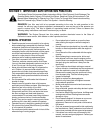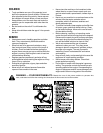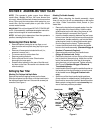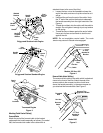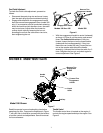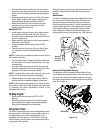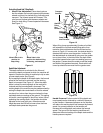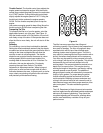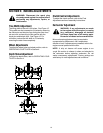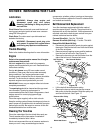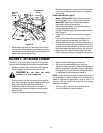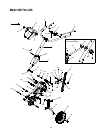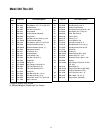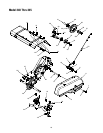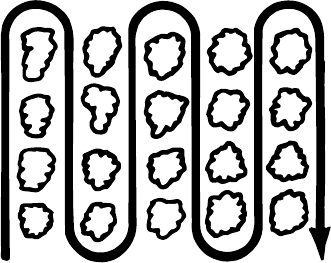
11
Throttle Control: The throttle control lever adjusts the
engine speed and stops the engine. With the throttle
control lever pushed completely forward, the carburetor
is in START position. Pulling the throttle control back
slightly adjusts the engine speed to FAST. Pulling the
throttle back further reduces the engine speed to
SLOW. Pull the throttle completely back to stop the
engine.
Use maximum engine speed for deep tilling. Move the
throttle control to SLOW when transporting the tiller.
Transporting The Tiller
To transport the tiller to or from the garden, pivot the
depth stake forward, out of the way. See Figure 12.
With the throttle control in SLOW position, the unit will
walk freely on top of the lawn. If the operator does not
allow the tiller to move freely, the unit will start to till the
surface.
Cultivating
For cultivating, a two to three inch depth is desirable.
Setting the wheels and depth stake so that the wheels
are about two inches above the ground while the tiller is
resting on the tines and depth stake will allow the
machine to work at cultivating depth. The throttle
should be set to control forward movement to a slow
walking speed. With the outer tines installed, the
working width of the machine is 22 or 24 inches. For
cultivation, this may be reduced to 13 inches by
removing the outer tines. Refer to Tine Width
Adjustment in Adjustment section. When laying out
plant rows, be sure to allow enough width to permit
cultivation between the rows. In growing corn or similar
crops, check-row planting will permit cross cultivation
and practically eliminate hand hoeing.
Figure 14
The tiller has many uses other than tilling and
cultivating a garden. One of these is the preparation of
lawn area for seeding. The tiller will prepare a deep
seed bed which will be free of hard untilled spots,
allowing a better stand of grass to grow. The tiller is
very useful for loosening hard soil for excavation with a
shovel. No tedious hand pickwork will be necessary.
Your tiller may be used for mixing compost in the pile,
or for mixing it with the soil in your garden. This should
be done after the soil has been broken to the full
working depth. The compost should be worked in to a
depth of six to seven inches. This may be done by
working the length of the garden, and then by making
separate passes across its width. The addition of
decayed organic matter will substantially increase the
fertility of your garden. For proper decaying action,
fertilizer should be applied and worked in with the
mulch materials. Breaking up leaves and straw and
mixing it with several inches of soil causes the soil to
hold moisture longer and allows proper aeration of the
plant root system. This also retards the growth of
weeds.
The U.S. Department of Agriculture and various state
and local agencies offer published booklets and expert
advice on all phases of gardening. They should be
consulted regarding soil information, planting dates,
and the most satisfactory varieties of crop for your
particular area.



